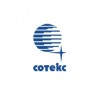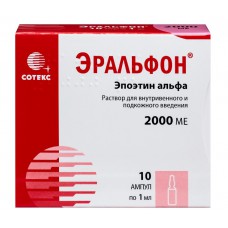Expiration date: 12/2027
Composition
1 syringe (1 ml) contains:
active substance: epoetin alpha (RAPOETIN-SP — recombinant human erythropoietin)
excipients: albumin solution in terms of dry albumin — 1 mg; sodium citrate pentasesquihydrate — 2.32 mg or sodium citrate dihydrate — 1.9104 mg; sodium chloride — 2.336 mg; citric acid monohydrate — 0.0228 mg; water for injection — up to 0.4 ml.
Pharmacological action
Epoetin alpha is a glycoprotein that specifically stimulates erythropoiesis, activates mitosis and maturation of erythrocytes from erythrocyte progenitor cells. Recombinant epoetin alpha is synthesized in mammalian cells, in which the gene encoding human erythropoietin is embedded. According to its composition, biological and immunological properties, epoetin alpha is identical to natural human erythropoietin. The introduction of epoetin alpha leads to an increase in hemoglobin and hematocrit levels, improved blood supply to tissues and heart function. The most pronounced effect of the use of epoetin alpha is observed in anemia caused by chronic renal failure. In very rare cases, with prolonged use of erythropoietin for the treatment of anemic conditions, the formation of neutralizing antibodies to erythropoietin may occur with or without the development of partial red cell aplasia.
Indications
- anemia in patients with chronic renal insufficiency, including those on hemodialysis;
- prevention and treatment of anemia in patients with solid tumors whose anemia was the result of antitumor therapy;
- prevention and treatment of anemia in patients infected with the human immunodeficiency virus (HIV) caused by the use of zidovudine, with endogenous erythropoietin levels less than 500 IU/ml;
- prevention and treatment of anemia in patients with myeloma, low-grade non-Hodgkin's lymphomas, chronic lymphocytic leukemia, rheumatoid arthritis;
- treatment and prevention of anemia in premature infants born with low body weight (up to 1.5 kg);
- as part of a pre-exposure program before extensive surgery in patients with a hematocrit level of 33-39% to facilitate the collection of autologous blood and reduce the risk associated with the use of allogeneic blood transfusions if the expected need for transfused blood exceeds the amount that can be obtained by autologous collection without the use of epoetin alpha;
- before performing an extensive operation with an expected blood loss of 900-1800 ml in adult patients without anemia or with mild to moderate anemia (hemoglobin level 100-130 g/l), to reduce the need for allogeneic hemotransfusions and facilitate the restoration of erythropoiesis.
Contraindications
- hypersensitivity to the drug Eralfon or its components;
- partial red cell aplasia after previous therapy with any erythropoietin;
- uncontrolled arterial hypertension;
- the inability to carry out adequate anticoagulant therapy;
- severe occlusive diseases of the coronary, carotid, cerebral and peripheral arteries and their consequences, including acute and recently suffered myocardial infarction and acute cerebrovascular accident (as part of a pre-exposure blood collection program before surgery).
With caution: malignant neoplasms; epileptic syndrome, including in the anamnesis; thrombocytosis, thrombosis (in the anamnesis); sickle cell anemia; iron-, B12- or folic deficiency; porphyria; chronic liver failure.
Side effects
At the beginning of treatment, flu-like symptoms may occur: dizziness, drowsiness, fever, headache, myalgia, arthralgia.
From the side of the cardiovascular system: dose—dependent increase in blood pressure, worsening of the course of arterial hypertension (most often in patients with chronic renal failure), in some cases - a hypertensive crisis, a sharp increase in blood pressure with symptoms of encephalopathy (headache, confusion) and generalized tonic-clonic seizures.
From the hematopoiesis organs: thrombocytosis, in some cases — thrombosis of the shunt or arteriovenous fistula (including hemodialysis patients with a tendency to hypotension or with aneurysm, stenosis), aplasia of the erythrocyte germ.
Allergic reactions: skin rash (mild or moderate), eczema, urticaria, itching, angioedema.
Local reactions: hyperemia, burning sensation, mild or moderate soreness at the injection site (more often occur with subcutaneous administration).
From the laboratory parameters: a decrease in serum ferritin concentration, with uremia — hyperkalemia, hyperphosphatemia.
Other: complications associated with respiratory disorders or with a decrease in blood pressure, immune reactions (induction of antibody formation), exacerbation of porphyria.
Interaction
Reduces the concentration of cyclosporine due to an increase in its binding to red blood cells (it may be necessary to adjust the dose of cyclosporine).
Pharmacologically incompatible with solutions of other drugs.
How to take it, the course of administration and dosage
Treatment of anemia in patients with chronic renal failure
Adults on hemodialysis. Eralphone is administered subcutaneously or intravenously at the end of a dialysis session. When changing the method of administration, the drug is administered at the same dose, then the dose is adjusted if necessary (with a subcutaneous method of administration, a dose 20-30% less is required to achieve the same therapeutic effect than with intravenous administration). Treatment with the drug includes two stages.
1. Correction stage: with subcutaneous administration of the drug, the initial single dose is 30 IU / kg 3 times a week. With intravenous administration of the drug, the initial single dose is 50 IU / kg 3 times a week. The correction period lasts until the optimal hemoglobin level is reached (100-120 g/ l in adults and 95-110 g / l in children) and hematocrit (30-35%). These indicators should be monitored weekly.
The following situations are possible:
- hematocrit increases from 0.5 to 1% per week. In this case, the dose is not changed until optimal performance is achieved.;
- the rate of increase in hematocrit is less than 0.5% per week. In this case, it is necessary to increase the single dose by 1.5 times;
- the growth rate is more than 1% per week. In this case, it is necessary to reduce the single dose of the drug by 1.5 times;
- hematocrit remains low or decreases. It is necessary to analyze the causes of resistance before increasing the dose of the drug.
The effectiveness of therapy depends on a well-chosen individual treatment regimen.
2. Stage of maintenance therapy: to maintain hematocrit at the level of 30-35%, the dose of the drug used at the correction stage should be reduced by 1.5 times. Then the maintenance dose of the drug is selected individually, taking into account the dynamics of hematocrit and hemoglobin levels.
Children on hemodialysis. The initial dose is 50 units / kg 3 times a week. If necessary, the single dose is increased once every 4 weeks by 25 units / kg until the optimal hemoglobin concentration is reached. The maintenance dose in children with a body weight of less than 10 kg is 75-150 U / kg (on average 100 U / kg) 3 times a week; 10-30 kg — 60-150 U / kg (on average 75 U / kg) 3 times a week; more than 30 kg — 30-100 U / kg (on average 33 Units / kg) 3 times a week.
Adult predialysis patients. The initial dose is administered subcutaneously or intravenously 3 times at 50 units / kg per week. If necessary, the single dose is increased 1 time every 4 weeks by 25 units / kg until the optimal hemoglobin concentration is reached. The maintenance dose is 17-33 units / kg 3 times a week.
Prevention and treatment of anemia in patients with solid tumors
Before starting treatment, it is recommended to determine the level of endogenous erythropoietin. When the concentration of serum erythropoietin is less than 200 IU / ml, the initial dose of the drug is 150 IU / kg 3 times a week with an intravenous method of administration. If, after 4 weeks of treatment, the hemoglobin level rises to at least 10 g / l or the number of reticulocytes has increased by more than 40,000 cells / µl above the baseline level, then the dose of the drug remains the same (150 IU / kg 3 times a week).
If, after 4 weeks of treatment, the increase in hemoglobin levels is less than 10 g / l and the increase in the number of reticulocytes is less than 40,000 cells / µl compared to the baseline level, then over the next 4 weeks the dose is increased to 300 IU / kg 3 times a week. If, after an additional 4 weeks of treatment at a dose of 300 IU / kg, the hemoglobin level has increased and is at least 10 g / l or the number of reticulocytes increases by more than 40,000 cells / ml, then the existing dose of the drug is maintained (300 IU / kg 3 times a week). If, after 4 weeks of treatment at a dose of 300 IU / kg, the hemoglobin level increased by less than 10 g / l and the increase in the number of reticulocytes is less than 40,000 cells / ml compared to the baseline level, treatment should be discontinued. In case of an increase in hemoglobin levels by more than 20 g / l within a month, the dose of the drug should be reduced by 25%. If the hemoglobin level exceeds 140 g / l, it is necessary to suspend treatment until the hemoglobin level drops below 120 g / l and then continue administration of the drug at a dose 25% lower than the initial one.
Therapy with the drug should continue for 1 month after the end of the course of chemotherapy.
The serum ferritin level (or serum iron level) should be determined in all patients before and during treatment with the drug. If necessary, additional iron intake is prescribed.
Prevention and treatment of anemia in patients with HIV infection
It is recommended to determine the initial level of endogenous erythropoietin in the blood serum before starting treatment with Eralfon. Studies have shown that with an erythropoietin level of more than 500 IU/ml, the effect of drug therapy is unlikely.
Treatment with the drug includes 2 stages.
Eralfon
(Epoetin
alfa)
- Brand: Sotex



